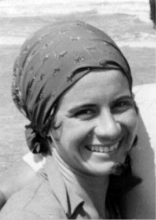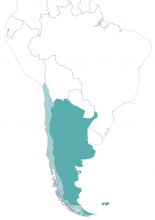María Cecilia Magnet Ferrero was born on December 3, 1948, in Santiago, Chile. She was the oldest of six children. The family moved in 1965 to Washington, D.C., United States, when the father, Alejandro Magnet, was appointed Ambassador to the Organization of American States (OAS) by President Eduardo Frei Montalva.
Ever since she was a child, María Cecilia showed a deep social commitment towards the poor, the popular sectors, a genuine yearning for social justice for her people. She was a special woman, full of talents and dreams, very vital, intelligent, profound, focused, very conscious of having had a privileged life. She had a sweet, mischievous look, her honey-coloured eyes, her wide smile, her generous hand.
María Cecilia finished high school in Maryland and then went on to study Sociology at Catholic University in D.C. Once she graduated, she returned to Chile in 1971 and, shortly after, the Argentine doctor Guillermo Tamburini, who joined the Revolutionary Left Movement (MIR), moved in with her. She joined the Popular Unitary Action Movement (MAPU), a political party linked to the peasantry and university student movements. María Cecilia carried out various tasks of popular advocacy (she lived for several months in the area of Lota and Coronel, a very poor zone in the south of the country).
In 1972, María Cecilia began studying Political Economy at the University of Chile. Her studies were interrupted by the coup d'état of September 11, 1973. She and her partner, Guillermo Tamburini, left Chile at the end of that year (separately) and later got married in January 1974 in Buenos Aires. He worked in a hospital in the city, and she worked in a language institute. They led a normal life, had friends, until the military coup in March 1976, in Argentina.
In July 1976, a woman who would not identify herself, called the Magnet Ferrero family home in Santiago, and asked to speak to Cecilia's father. In short, the woman told him that his daughter had been in an accident, and it was not a car accident. Her father travelled to Buenos Aires a few days later. The apartment they occupied at 3386 Córdoba Avenue, fourth floor, had been broken into and ransacked. Cecilia's wedding ring was found under her bed.
The neighbours, paralysed by fear, refused to talk. Her father only managed to find out that both were kidnapped from the apartment around four o'clock in the morning of July 16, 1976. A young man saw how she was forced into an Army vehicle. According to the same source, Tamburini allegedly shouted his name and that of his wife, identified himself as a doctor and when he resisted arrest, he was shot and wounded. His body was apparently left on the sidewalk for several hours. Cecilia was 27 years old at the time of her disappearance. Tamburini was 32.
The Rettig Commission, created in Chile in 1990 following the return of democracy, affirmed that, in view of the evidence available, that Guillermo Tamburini and María Cecilia Magnet were victims of forced disappearance, with their human rights being violated. At that time, the Commission considered that it did not have sufficient elements to adjudicate to the State of Chile the responsibility in the events that harmed the couple. Their case was also probed by the CONADEP Commission of Argentina.
Cecilia's disappearance and that of her husband, in the context of Operation Condor, was one of the cases incorporated - 94 in total - by Judge Baltasar Garzón in Spain to prosecute Pinochet in 1998. On September 10, 2004, the Magnet Ferrero family filed a criminal complaint in Santiago against General Augusto Pinochet and those responsible for the crimes of kidnapping, illicit association and other related crimes suffered by María Cecilia Magnet.
The case of María Cecilia was one of the 23 cases of Chilean citizens that were part of the "Operation Condor" trial carried out in Argentina and whose sentence was handed down on May 27, 2016. On that day, at the close of the trial, Humberto José Román Lobaiza (89 years old) and Felipe Jorge Alespeiti (87 years old), were the only two accused for the kidnapping and disappearance of María Cecilia. The former was sentenced to 18 years in prison and the latter to 12 years. Humberto Lobaiza was an army colonel at the time of the kidnapping, and he retired in 1980. In July 1976, Felipe Alespeiti was an army lieutenant colonel, head of the I Patricio Infantry Regiment and, as such, head of Area II of the Capital Federal subzone. He retired from the Argentine Army in May 1977 and died in July 2016. Both were already serving house arrest for other crimes against humanity.
Within the framework of the Condor trial, the evidence gathered allowed to prove the responsibility of the Chilean state in the disappearance of María Cecilia and Guillermo. The exchange of information between the different security agencies to repress and persecute Chilean opponents of the Chilean regime was proven, as well as the presence of Chilean agents who contributed -by providing information and being present in Buenos Aires- to the kidnapping of the couple.
This text was written and translated by her sister, Odette Magnet Ferrero


